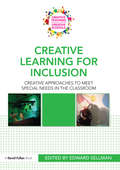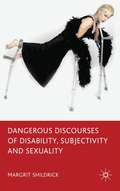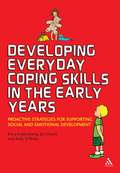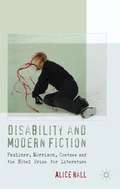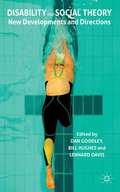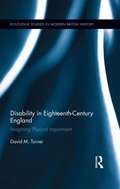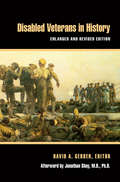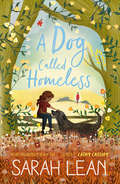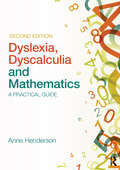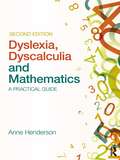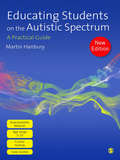- Table View
- List View
Creative Learning for Inclusion: Creative approaches to meet special needs in the classroom (Creative Teaching/Creative Schools)
by Edward SellmanIntroducing creativity to the classroom is a concern for teachers, governments and future employers around the world, and there has been a drive to make experiences at school more exciting, relevant, challenging and dynamic for all young people, ensuring they leave education able to contribute to the global creative economy. Creative Learning to Meet Special Needs shows teachers how to use creativity in the curriculum for key stages 2 and 3 to support the learning of pupils with special educational needs in a way which effectively engages them and leaves a lasting impact on their school experiences and later lives. Describing the different ways in which a creative approach can help pupils with SEN access the curriculum, with activities and practical materials for teachers, this book will explain: why creativity is central to making the curriculum accessible how to use personalised learning with pupils with SEN how to promote achievements and motivation through creative experiences how the curriculum can be extended and represented in innovative ways for pupils with SEN how to use interactive methods of teaching and alternative methods of communication. Providing case studies and examples of the ways in which teachers have delivered the curriculum creatively to pupils with special educational needs, this book is an invaluable guide for all those involved in teaching and engaging young people with special needs.
Creative Learning for Inclusion: Creative approaches to meet special needs in the classroom (Creative Teaching/Creative Schools)
by Edward SellmanIntroducing creativity to the classroom is a concern for teachers, governments and future employers around the world, and there has been a drive to make experiences at school more exciting, relevant, challenging and dynamic for all young people, ensuring they leave education able to contribute to the global creative economy. Creative Learning to Meet Special Needs shows teachers how to use creativity in the curriculum for key stages 2 and 3 to support the learning of pupils with special educational needs in a way which effectively engages them and leaves a lasting impact on their school experiences and later lives. Describing the different ways in which a creative approach can help pupils with SEN access the curriculum, with activities and practical materials for teachers, this book will explain: why creativity is central to making the curriculum accessible how to use personalised learning with pupils with SEN how to promote achievements and motivation through creative experiences how the curriculum can be extended and represented in innovative ways for pupils with SEN how to use interactive methods of teaching and alternative methods of communication. Providing case studies and examples of the ways in which teachers have delivered the curriculum creatively to pupils with special educational needs, this book is an invaluable guide for all those involved in teaching and engaging young people with special needs.
Dangerous Discourses Of Disability, Subjectivity And Sexuality
by Margrit ShildrickThis innovative and adventurous work, now in paperback, uses broadly feminist and postmodernist modes of analysis to explore what motivates damaging attitudes and practices towards disability. The book argues for the significance of the psycho-social imaginary and suggests a way forward in disability's queering of normative paradigms.
Developing Everyday Coping Skills in the Early Years: Proactive Strategies for Supporting Social and Emotional Development
by Erica Frydenberg Jan Deans Kelly O'BrienThis book will help develop coping skills through arts and language-based activities. The strategies suggested build on children's existing knowledge and skills to enhance their learning, and will all contribute to: · improving all children's emotional health and creativity · developing resilience, particularly in periods of high stress such as transition from preschool to school · increasing children's capacity to cooperate, respect and play with others The authors also explain how to identify children at risk, particularly those experiencing anxiety or delay in social and emotional development, so that parents and practitioners can intervene early where difficulties exist. Practitioners and parents of children aged 3-8 will find a treasure trove of activities to build coping and self-esteem through creative play and imagination.
Disability And Modern Fiction: Faulkner, Morrison, Coetzee And The Nobel Prize For Literature (PDF)
by Alice HallFocusing on Faulkner, Morrison and Coetzee as authors, critics and Nobel Prize-winning intellectuals, this book explores shifting representations of disability in 20th and 21st century literature and proposes new ways of reading their works in relation to one another, whilst highlighting the ethical, aesthetic and imaginative challenges they pose.
Disability And Modern Fiction: Faulkner, Morrison, Coetzee And The Nobel Prize For Literature
by Alice HallFocusing on Faulkner, Morrison and Coetzee as authors, critics and Nobel Prize-winning intellectuals, this book explores shifting representations of disability in 20th and 21st century literature and proposes new ways of reading their works in relation to one another, whilst highlighting the ethical, aesthetic and imaginative challenges they pose.
Disability And Social Theory: New Developments And Directions (PDF)
by Dan Goodley Bill Hughes Lennard DavisThis comprehensive, interdisciplinary collection examines disability from a theoretical perspective. Each chapter challenges dominant biological, individualistic and psychological views of disability, drawing on one or two theories (and theorists) to advance a sustained analysis of disability, impairment and society. Throughout, social theories of disability intersect with other transformative ideas around sex/gender, race/ethnicity, class, sexuality and nation, engaging with ideas from poststructuralism, phenomenology, psychoanalysis, postcolonialism, Marxism, feminisms and queer theory to recast disabled bodies-and-minds as psychosocial, cultural and political phenomena. The book includes contributions from established writers as well as new, emerging and exciting scholars in the field of critical disability studies, with authors writing from a host of disciplines including legal studies, psychology, sociology, development studies, dance, education, philosophy and women's studies. Through its detailed analysis of the conditions of disablism, the text also argues for the celebration of more affirmative views of impairment, disability and di
Disability And Social Theory: New Developments And Directions
by Dan Goodley Bill Hughes Lennard DavisThis comprehensive, interdisciplinary collection examines disability from a theoretical perspective. Each chapter challenges dominant biological, individualistic and psychological views of disability, drawing on one or two theories (and theorists) to advance a sustained analysis of disability, impairment and society. Throughout, social theories of disability intersect with other transformative ideas around sex/gender, race/ethnicity, class, sexuality and nation, engaging with ideas from poststructuralism, phenomenology, psychoanalysis, postcolonialism, Marxism, feminisms and queer theory to recast disabled bodies-and-minds as psychosocial, cultural and political phenomena. The book includes contributions from established writers as well as new, emerging and exciting scholars in the field of critical disability studies, with authors writing from a host of disciplines including legal studies, psychology, sociology, development studies, dance, education, philosophy and women's studies. Through its detailed analysis of the conditions of disablism, the text also argues for the celebration of more affirmative views of impairment, disability and di
Disability in Eighteenth-Century England: Imagining Physical Impairment
by David M. TurnerThis is the first book-length study of physical disability in eighteenth-century England. It assesses the ways in which meanings of physical difference were formed within different cultural contexts, and examines how disabled men and women used, appropriated, or rejected these representations in making sense of their own experiences. In the process, it asks a series of related questions: what constituted 'disability' in eighteenth-century culture and society? How was impairment perceived? How did people with disabilities see themselves and relate to others? What do their stories tell us about the social and cultural contexts of disability, and in what ways were these narratives and experiences shaped by class and gender? In order to answer these questions, the book explores the languages of disability, the relationship between religious and medical discourses of disability, and analyzes depictions of people with disabilities in popular culture, art, and the media. It also uncovers the 'hidden histories' of disabled men and women themselves drawing on elite letters and autobiographies, Poor Law documents and criminal court records. 9780203117545
Disabled Veterans in History: Discourses Of Disability: Disabled Veterans In History (Corporealities: Discourses Of Disability)
by David A. GerberDisabled Veterans in History explores the long-neglected history of those who have sustained lasting injuries or chronic illnesses while serving in uniform. The contributors to this volume cover an impressive range of countries in Europe and North America as well as a wide sweep of chronology from the Ancient World to the present. This revised and enlarged edition, available for the first time in paperback, has been updated to reflect the new realities of war injuries in the 21st century, including PTSD. The book includes an afterword by noted Veterans Administration psychiatrist and MacArthur Award winner Jonathan Shay, a new preface, and an added essay on the changing nature of the American war hero.
A Dog Called Homeless: A Dog Called Homeless, A Horse For Angel, The Forever Whale
by Sarah LeanMy name is Cally Louise Fisher and I haven't spoken for thirty-one days. Talking doesn’t always make things happen, however much you want them to.
Dyslexia, Dyscalculia and Mathematics: A practical guide
by Anne HendersonDyslexia, Dyscalculia and Mathematics will be an essential resource for teachers, classroom assistants, and SENCOs who help dyslexic and dyscalculic children with their understanding of mathematics. Written in an accessible style with helpful illustrations, this practical book reveals helpful ways in which to tackle both simple and complex concepts with students of all ages. This second edition has been updated to include references to using technology that will help children with dyslexia and dyscalculia reinforce their mathematical skills and also contains a number of photocopiable resources that can be used in the classroom. Written by Anne Henderson, who is experienced in teaching language and mathematics to pupils with dyslexia and dyscalculia, this book outlines current thinking in the field and shows how the research methods that have been proven as successful can be used with whole classes of children. This book encourages flexible methods and gives teachers the confidence to discuss alternative solutions with their pupils and help them achieve success. It is an ideal handbook for parent-teacher programmes and is also suitable for in-service training.
Dyslexia, Dyscalculia and Mathematics: A practical guide
by Anne HendersonDyslexia, Dyscalculia and Mathematics will be an essential resource for teachers, classroom assistants, and SENCOs who help dyslexic and dyscalculic children with their understanding of mathematics. Written in an accessible style with helpful illustrations, this practical book reveals helpful ways in which to tackle both simple and complex concepts with students of all ages. This second edition has been updated to include references to using technology that will help children with dyslexia and dyscalculia reinforce their mathematical skills and also contains a number of photocopiable resources that can be used in the classroom. Written by Anne Henderson, who is experienced in teaching language and mathematics to pupils with dyslexia and dyscalculia, this book outlines current thinking in the field and shows how the research methods that have been proven as successful can be used with whole classes of children. This book encourages flexible methods and gives teachers the confidence to discuss alternative solutions with their pupils and help them achieve success. It is an ideal handbook for parent-teacher programmes and is also suitable for in-service training.
Dyslexia, Languages and Multilingualism (PDF)
by John EverattPopulations are becoming more mobile, leading to sometimes dramatic changes in societies. These changes can lead to classrooms in which children speak a home/first language that is different from the language of education. In places of relatively large immigration, there may be a range of home/first languages spoken by children in a local school – in one, near to the University of Canterbury, New Zealand, over a dozen first languages were spoken by young children in a recent class, despite English being the only language spoken by their teacher.
Educating Children and Young People with Fetal Alcohol Spectrum Disorders: Constructing Personalised Pathways to Learning
by Carolyn Blackburn Barry Carpenter Jo EgertonThe range of learning difficulties associated with children who have fetal alcohol spectrum disorders (FASDs) has been highlighted as an emerging but little understood area of Special Educational Needs. This engaging, timely, and highly practical book will raise awareness about FASDs and their associated difficulties across the entire education workforce. It provides a range of specialist, practical tried-and-tested teaching and learning strategies, from which teachers and support staff may construct personalised learning plans for students with FASDs, and will help improve outcomes for all their children. It also: explains the impact that FASDs can have on the child’s brain; discusses the overlapping and co-existing disorders, such as ADHD and autism spectrum disorders; shows how to support and empower teachers; provides ready-to-use teaching resources and strategies that can be used directly in the classroom. Informed by the very latest research and written by leading experts in the field, Educating Children and Young People with Fetal Alcohol Spectrum Disorders will prove invaluable for experienced teachers and teaching assistants who are engaging in Continuing Professional Development, as well as newly qualified and training Initial Teacher Training students.
Educating Children and Young People with Fetal Alcohol Spectrum Disorders: Constructing Personalised Pathways to Learning
by Carolyn Blackburn Barry Carpenter Jo EgertonThe range of learning difficulties associated with children who have fetal alcohol spectrum disorders (FASDs) has been highlighted as an emerging but little understood area of Special Educational Needs. This engaging, timely, and highly practical book will raise awareness about FASDs and their associated difficulties across the entire education workforce. It provides a range of specialist, practical tried-and-tested teaching and learning strategies, from which teachers and support staff may construct personalised learning plans for students with FASDs, and will help improve outcomes for all their children. It also: explains the impact that FASDs can have on the child’s brain; discusses the overlapping and co-existing disorders, such as ADHD and autism spectrum disorders; shows how to support and empower teachers; provides ready-to-use teaching resources and strategies that can be used directly in the classroom. Informed by the very latest research and written by leading experts in the field, Educating Children and Young People with Fetal Alcohol Spectrum Disorders will prove invaluable for experienced teachers and teaching assistants who are engaging in Continuing Professional Development, as well as newly qualified and training Initial Teacher Training students.
Educating Students on the Autistic Spectrum: A Practical Guide
by Dr Martin HanburyThe aim of this book is to make sure all students on the Autistic Spectrum are given the opportunity to engage in appropriate teaching and learning experiences. It considers the individual with autism, and offers tried and tested approaches that have worked, giving background information on autism and its impact on the learner. In this new edition, the author has added: - more information on sensory issues - an increasingly holistic view of the student with autism - new ideas for curriculum planning in mainstream settings - advice on multi-professional working - guidance on developing positive working relationships with parents and carers There is a wealth of new electronic material available to download from the SAGE website, including photocopiable materials, PowerPoint presentations and checklists. A must-have resource for all practitioners working with children and young people on the autistic spectrum, this book will improve your inclusive practice and ensure positive outcomes for these children.
Educating Students on the Autistic Spectrum: A Practical Guide
by Dr Martin HanburyThe aim of this book is to make sure all students on the Autistic Spectrum are given the opportunity to engage in appropriate teaching and learning experiences. It considers the individual with autism, and offers tried and tested approaches that have worked, giving background information on autism and its impact on the learner. In this new edition, the author has added: - more information on sensory issues - an increasingly holistic view of the student with autism - new ideas for curriculum planning in mainstream settings - advice on multi-professional working - guidance on developing positive working relationships with parents and carers There is a wealth of new electronic material available to download from the SAGE website, including photocopiable materials, PowerPoint presentations and checklists. A must-have resource for all practitioners working with children and young people on the autistic spectrum, this book will improve your inclusive practice and ensure positive outcomes for these children.
Effective Inclusive Schools: Designing Successful Schoolwide Programs
by Thomas Hehir Lauren I. KatzmanHow to raise the achievement of all kids, from gifted to those with severe disabilities This book presents lessons learned from in-depth case studies of some of our most effective inclusive public schools. The authors conclusively demonstrate that schools can educate students with mild and severe disabilities in general education classrooms by providing special education services that link to and bolster general education instruction. This goes beyond complying with Special Education law; having a truly inclusive environment raises the achievement level for all students and results in more committed and satisfied teachers. Insights shared from teachers, school leaders, parents, and the students themselves provide a path forward for anyone striving to Improve special education services. The authors reveal what these exemplary schools do that makes them so successful, and provide advice for readers who want to incorporate these practices themselves. Hehir, former U.S. Office of Special Education (OSEP) Director, is a leading name in Special Education Highlights the important relationships between administrators, teachers, and parents to foster maximum collaboration between general and special education Includes information on committing to Universal Design for Learning (UDL) and Positive Behavior Supports This vital resource zeroes in on what excellent public schools do differently to ensure all students succeed.
Effective Inclusive Schools: Designing Successful Schoolwide Programs
by Thomas Hehir Lauren I. KatzmanHow to raise the achievement of all kids, from gifted to those with severe disabilities This book presents lessons learned from in-depth case studies of some of our most effective inclusive public schools. The authors conclusively demonstrate that schools can educate students with mild and severe disabilities in general education classrooms by providing special education services that link to and bolster general education instruction. This goes beyond complying with Special Education law; having a truly inclusive environment raises the achievement level for all students and results in more committed and satisfied teachers. Insights shared from teachers, school leaders, parents, and the students themselves provide a path forward for anyone striving to Improve special education services. The authors reveal what these exemplary schools do that makes them so successful, and provide advice for readers who want to incorporate these practices themselves. Hehir, former U.S. Office of Special Education (OSEP) Director, is a leading name in Special Education Highlights the important relationships between administrators, teachers, and parents to foster maximum collaboration between general and special education Includes information on committing to Universal Design for Learning (UDL) and Positive Behavior Supports This vital resource zeroes in on what excellent public schools do differently to ensure all students succeed.
The Effective Teacher's Guide to Autism and Communication Difficulties: Practical strategies (The\effective Teacher's Guides)
by Michael FarrellIn this welcome second edition of The Effective Teacher‘s Guide to Autism and Communication Difficulties, best-selling author Michael Farrell addresses how teachers and others can develop provision for students with autism and students that have difficulties with speech, grammar, meaning, use of language and comprehension. Updated and expanded, thi
The Effective Teacher's Guide to Autism and Communication Difficulties: Practical strategies
by Michael FarrellIn this welcome second edition of The Effective Teacher‘s Guide to Autism and Communication Difficulties, best-selling author Michael Farrell addresses how teachers and others can develop provision for students with autism and students that have difficulties with speech, grammar, meaning, use of language and comprehension. Updated and expanded, thi
The Effective Teacher's Guide to Dyslexia and other Learning Difficulties: Practical strategies (The Effective Teacher's Guides)
by Michael FarrellThis highly anticipated second edition of The Effective Teacher's Guide to Dyslexia and other Learning Difficulties (Learning Disabilities) critically examines the specificity and complexity of learning disabilities. The user-friendly text highlights the importance of schools reviewing their curricula and assessment, pedagogical methods, resources, organisation and therapy procedures to ensure that their provision helps encourage academic progress and the best personal and social development for their pupils. This book accessibly and authoritatively addresses a range of issues associated with: Reading disorders / dyslexia Disorder of written expression/ dysgraphia Developmental co-ordination disorder/ dyspraxia Mathematics disorder/ dyscalculia. Offering what works in the classroom, this text also takes into account the relationship between professionals who work closely with parents and other professionals. It helpfully recognises the importance of professional contributions and the foundational disciplines that contribute to special education. Underpinned by research and widely held professional opinions, this second edition of The Effective Teacher's Guide to Dyslexia and other Learning Difficulties (Learning Disabilities) will prove a practical, readable and invaluable resource for the busy teacher, students on initial teacher training courses, school managers and administrators.
The Effective Teacher's Guide to Dyslexia and other Learning Difficulties: Practical strategies (The Effective Teacher's Guides)
by Michael FarrellThis highly anticipated second edition of The Effective Teacher's Guide to Dyslexia and other Learning Difficulties (Learning Disabilities) critically examines the specificity and complexity of learning disabilities. The user-friendly text highlights the importance of schools reviewing their curricula and assessment, pedagogical methods, resources, organisation and therapy procedures to ensure that their provision helps encourage academic progress and the best personal and social development for their pupils. This book accessibly and authoritatively addresses a range of issues associated with: Reading disorders / dyslexia Disorder of written expression/ dysgraphia Developmental co-ordination disorder/ dyspraxia Mathematics disorder/ dyscalculia. Offering what works in the classroom, this text also takes into account the relationship between professionals who work closely with parents and other professionals. It helpfully recognises the importance of professional contributions and the foundational disciplines that contribute to special education. Underpinned by research and widely held professional opinions, this second edition of The Effective Teacher's Guide to Dyslexia and other Learning Difficulties (Learning Disabilities) will prove a practical, readable and invaluable resource for the busy teacher, students on initial teacher training courses, school managers and administrators.
The Effective Teacher's Guide to Moderate, Severe and Profound Learning Difficulties: Practical strategies (The Effective Teacher's Guides)
by Michael FarrellThis updated second edition of The Effective Teachers Guide to Moderate, Severe and Profound Learning Difficulties (Cognitive Impairments) has been restructured and expanded to ensure it continues to meet the needs of the busy teacher. This new edition is highly relevant and contextualized, drawing on the curriculum and assessment, pedagogy, resources, therapy and care and school and classroom organisation. It is accessible and practical in approach yet offers the necessary underpinning of research and professional knowledge to enable the teacher to be self-critical in developing classroom approaches. The book accessibly and thoroughly discusses the classroom difficulties associated with: Mild cognitive impairment Moderate to severe cognitive impairment Profound cognitive impairment Conditions associated with cognitive impairment. A much needed source of knowledge for teachers, students on initial teacher training courses, school managers, and administrators, this book will be of interest to anyone who supports children and young people with cognitive impairments.
